How to Make 3d Drawing in Autocad 2013
Chapter 1. Introduction to 3D Design
Welcome to the fantastic world of 3D! AutoCAD is an excellent software for creating 2D projects in all technical areas, but instead of 2D representation, isn't it much better if we could create accurate 3D models, view them from all perspectives (even from inside), and get 2D drawings easily? With AutoCAD we can!
The topics covered in this chapter are as follows:
-
The importance of the third coordinate
-
How to choose and manage 3D workspaces
-
Why object properties are fundamental in 3D
-
How auxiliary tools (osnap, ortho, and others) can ease the work in 3D
-
2D commands in a 3D world
-
How to use linear 3D commands
-
How to create great 3D models
The Z coordinate
3D is all about the third Z coordinate. In 2D, we only care for the X and Y axes, but never used the Z axis. And most of the time, we don't even use coordinates, just the top-twenty AutoCAD commands, the Ortho tool, and so on. But in 3D, the correct use of coordinates can substantially accelerate our work. We will first briefly cover how to introduce points by coordinates and how to extrapolate to the third dimension.
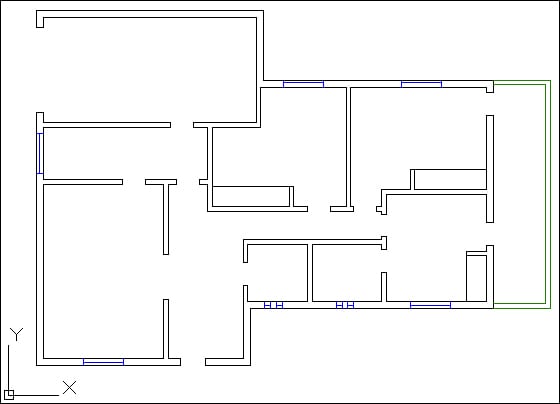
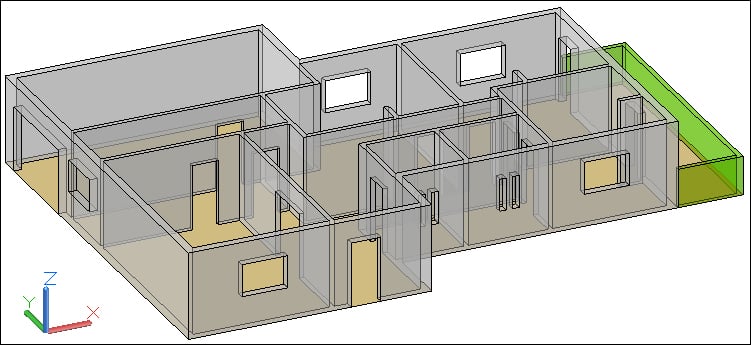
Absolute coordinates
The location of all entities in AutoCAD is related to a coordinate system. Any coordinate system is characterized by an origin and positive directions for the X and Y axes. The Z axis is obtained directly from the X and Y axes by the right-hand rule: if we rotate the right hand from the X axis to the Y axis, the thumb indicates the positive Z direction.
Picture that when prompting for a point; besides specifying it in the drawing area with a pointing device such as a mouse, we can enter coordinates using the keyboard.
The format for the absolute Cartesian coordinates related to the origin is defined by the values of the three orthogonal coordinates, namely, X, Y, and Z, separated by commas:
X coordinate, Y coordinate, Z coordinate
The Z coordinate can be omitted.
For instance, if we define a point with the absolute coordinates 30, 20, and 10, this means 30 absolute is in the X direction, 20 is in the Y direction, and 10 is in the Z direction.
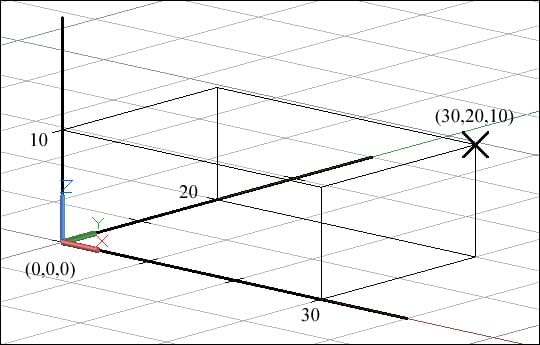
Relative coordinates
Frequently, we want to specify a point in the coordinates, but one that is related to the previous point. The format for the relative Cartesian coordinates is defined by the symbol AT ( @ ), followed by increment values in the three directions, separated by commas:
@X increment, Y increment, Z increment
Of course, one or more increments can be 0. The Z increment can be omitted.
For instance, if we define a point with relative coordinates, @0,20,10, this means in relation to the previous point, 0 is in X, 20 is in Y, and 10 is in Z directions.
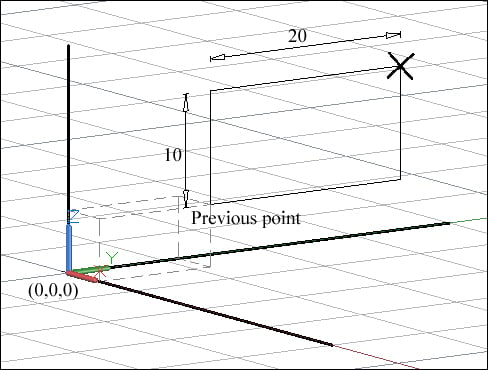
Point filters
When we want to specify a point but decompose it step-by-step, that is, separate its coordinates based on different locations, we may use filters. When prompting for a point, we access filters by digitizing the X, Y, or Z axes for individual coordinates, or XY, YZ, or ZX for pairs of coordinates. Another way is from the osnap menu, CTRL + mouse right-click, and then Point Filters . AutoCAD requests for the remaining coordinates until the completion of point definition.
Imagine that we want to specify a point, for instance, the center of a circle, where its X coordinate is given by the midpoint of an edge, its y coordinate is the midpoint of another edge, and finally its Z coordinate is any point on a top face. Assuming that Midpoint osnap is predefined, the dialog should be:
Command: CIRCLE Specify center point for circle or [3P/2P/Ttr (tan tan radius)]: .X of midpoint of edge (need YZ): .Y of midpoint of edge (need Z): any point on top face Specify radius of circle or [Diameter]: value
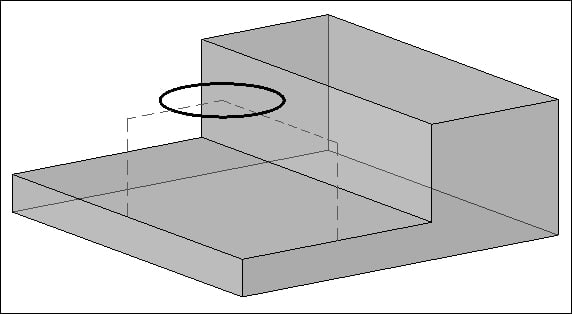
Workspaces
AutoCAD comes with several workspaces. It's up to each of us to choose a workspace based on a classic environment or the ribbon. To change workspaces, we can pick the workspace switching button on the status bar:
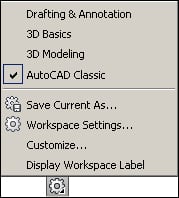
There are other processes for acceding this command such as the workspaces list on the Quick Access Toolbar (title bar), the Workspaces toolbar, or by digitizing WSCURRENT, but the access shown is consistent among all versions and always available.
Classic environment
The classic environment is based on the toolbars and the menu bar and doesn't use the ribbon. AutoCAD comes with AutoCAD Classic workspace, but it's very simple to adapt and view the suitable toolbars for 3D.
The advantages of using this environment are speed and consistency. To show another toolbar, we right-click over any toolbar and choose it. Typically, we want to have the following toolbars visible besides Standard and Layers: Layers II, Modeling, Solid Editing, and Render:

Ribbon environment
Since the 2009 version, AutoCAD also allows for a ribbon-based environment. Normally, this environment uses neither toolbars nor the menu bar. AutoCAD comes with two ribbon workspaces, namely, 3D Basics and 3D Modeling; the first being less useful than the second.
The advantages are that we have consistency with other software, commands are divided into panels and tabs, the ribbon can be collapsed to a single line, and it includes some commands not available on the toolbars. The disadvantage is that as it's a dynamic environment, we frequently have to activate other panels to access commands and some important commands and functions are not always visible:

Note
When modeling in 3D, the layers list visibility is almost mandatory. We may add this list to the Quick Access Toolbar by applying the CUI command or by right-clicking above the command icon we want to add. Another way is to pull the Layers panel to the drawing area, thus making it permanently visible.
Layers, transparency, and other properties
When we are modeling in AutoCAD, the ability to control object properties is essential. After some hours spent on a new 3D model, we can have hundreds of objects that overlap and obscure the model's visibility. Here are the most important properties.
Layers
If a correct layers application is fundamental in 2D, in 3D it assumes extreme importance. Each type of 3D object should be in a proper layer, thus allowing us to control its properties:
-
Name : A good piece of advice is to not mix 2D with 3D objects in the same layers. So, layers for 3D objects must be easily identified, for instance, by adding a 3D prefix.
-
Freeze/Thaw : In 3D, the density of screen information can be huge. So freezing and unfreezing layers is a permanent process. It's better to freeze the layers than to turn off because objects on frozen layers are not processed (for instance, regenerating or counting for
ZOOMExtents ), thus accelerating the 3D process. -
Lock/Unlock : It's quite annoying to notice that at an advanced phase of our project, our walls moved and caused several errors. If we need that information visible, the best way to avoid these errors is to lock layers.
-
Color : A good and logical color palette assigned to our layers can improve our understanding while modeling.
-
Transparency : If we want to see through walls or other objects at the creation process, we may give a value between 0 and 90 percent to the layers transparency.
Last but not least, the best and the easiest process to assign rendering materials to objects is by layer, so another good point is to apply a correct and detailed layer scheme.
Transparency
Transparency, as a property for layers or for objects, has been available since Version 2011. Besides its utility for layers, it can also be applied directly to objects. For instance, we may have a layer called 3D-SLAB and just want to see through the upper slab. We can change the objects' transparency with PROPERTIES ( Ctrl + 1 ).
To see transparencies in the drawing area, the TPY button (on the status bar) must be on.
Visibility
Another recent improvement in AutoCAD is the ability to hide or to isolate objects without changing layer properties.
We select the objects to hide or to isolate (all objects not selected are hidden) and right-click on them. On the cursor menu, we choose Isolate and then:
-
Isolate Objects : All objects not selected are invisible, using the
ISOLATEOBJECTScommand -
Hide Objects : The selected objects are invisible, using the
HIDEOBJECTScommand -
End Object Isolation : All objects are turned on, using the
UNISOLATEOBJECTScommand.
There is a small lamp icon on the status bar, the second icon from the right. If the lamp is red, it means that there are hidden objects; if it is yellow, all objects are visible:
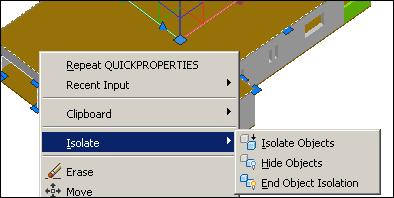
Shown on the following image is the application of transparency and hide objects to the left wall and the upper slab:

Auxiliary tools
AutoCAD software is very precise and the correct application of these auxiliary tools is a key factor for good projects. All users should be familiar with at least Ortho and Osnap tools. Following is the application of auxiliary tools in 3D projects complemented with the first exercise.
OSNAP, ORTHO, POLAR, and OTRACK auxiliary tools
Let's start with object snapping, probably the most frequently used tool for precision. Every time AutoCAD prompts for a point, we can access predefined object snaps (also known as osnaps) if the OSNAP button on the status bar is on. To change it, we only have to click on the OSNAP button or press F3 . If we want an individual osnap, we can, among other ways, digitize the first three letters (for instance, MID for midpoint) or use the osnap menu ( CTRL + right-click). Osnaps work everywhere in 3D (which is great) and is especially useful is the Extension osnap mode, which allows you to specify a point with a distance in the direction of any edge.
But what if we want to specify the projection of 3D points onto the working XY plane? Easy! If the OSNAPZ variable is set to 1, all specified points are projected onto the plane. This variable is not saved and 0 is assigned as the initial value.
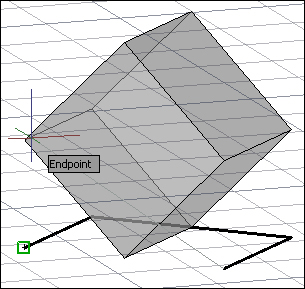
More great news is that ORTHO ( F8 ) and POLAR ( F10 ) work in 3D. That is, we can specify points by directing the cursor along the Z axis and assign distances. Lots of @ spared, no?
OTRACK ( F11 ), used to derive points from predefined osnaps, also works along the Z-axis direction. We pause over an osnap and can assign a distance along a specific direction or just obtain a crossing:
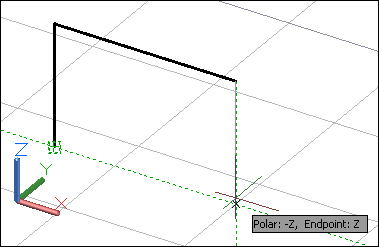
3DOsnap tool
Starting with Version 2011, AutoCAD allows you to specify 3D object snaps. Also, here we can access predefined 3D osnaps keeping 3DOSNAP ( F4 ) on, or we can access them individually. There are osnaps for vertices, midpoints on edges, centers of faces, knots (spline points), points perpendicular to faces, and points nearest to faces.
Exercise 1.1
Using the LINE command, coordinates, and auxiliary tools, let's create a cabinet skeleton. All dimensions are in meters and we start from the lower-left corner. The ORTHO or POLAR button must be on and the OTRACK and OSNAP buttons with Endpoint and Midpoint predefined.
Note
As in 2D, rotating the wheel mouse forward, we zoom in; rotating the wheel backward, we zoom out; all related to cursor position. To automatically orbit around the model, we hold down SHIFT and the wheel simultaneously. The cursor changes to two small ellipses and then we drag the mouse to orbit around the model. Visualization is the subject of the next chapter.
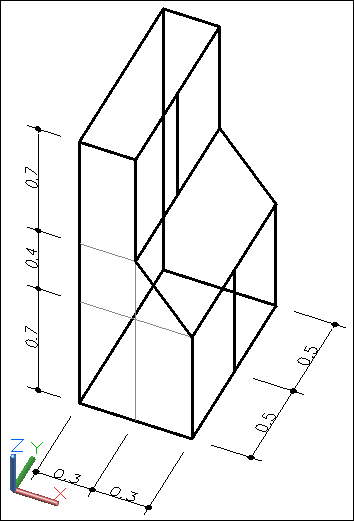
-
We run the
LINEcommand at any point, block direction X ( POLAR or ORTHO ) and assign the distance:Command: LINE Specify first point: any point Specify next point or [Undo]: 0.6
-
We block the Z direction and assign the distance:
Specify next point or [Undo]: 0.7 -
The best way to specify this point is with relative coordinates:
Specify next point or [Close/Undo]: @-0.3,0,0.4 -
We block the Z direction and assign the distance:
Specify next point or [Close/Undo]: 0.7 -
The best way to close the left polygon is to pause over the first point, move the cursor up to find the crossing, with Polar or Ortho coming from the last point, and apply Close option to close the polygon:
Specify next point or [Close/Undo]: point with OTRACK Specify next point or [Close/Undo]: C
-
We copy all lines 1 meter in the Y direction:
Command: COPY Select objects: Specify opposite corner: 6 found Select objects: Enter Current settings: Copy mode = Multiple Specify base point or [Displacement/mOde] <Displacement>: point Specify second point or [Array] <use first point as displacement>: 1 Specify second point or [Array/Exit/Undo] <Exit>: Enter
-
We complete the cabinet skeleton by drawing lines between endpoints and midpoints:
Application of 2D commands
Can those everyday commands be used in 3D? Of course they can! We have already seen the LINE command, layers, and other properties. Let's see some particularities and 3D applications and learn that a whole bunch of known commands can also be applied.
Drawing commands
Basically, all drawing commands can be used in 3D, provided that we have the correct working plane, LINE being the exception.
The LINE command can have its endpoints anywhere, so it's a real 3D command. But circles, arcs, and polylines (including polygons and rectangles) are drawn on the working plane (called active coordinate system) or a plane parallel to the working plane.
Editing commands
Here is the list of the most important editing commands that work the same way in 2D or 3D: ERASE, MOVE, COPY, SCALE, JOIN, EXPLODE, and BREAK.
Some commands work only on the objects plane, not necessary the active working plane. Examples are FILLET, CHAMFER, and OFFSET.
There are also some that work only in relation to the active working plane such as MIRROR, ARRAYCLASSIC (ARRAY before version 2012), and ROTATE.
Next are editing commands that have special 3D features:
-
TRIMandEXTEND: Both commands have an option, Project , which specifies if linear objects are cut or extended to the boundaries related to the current coordinate system or the current view. This allows for cutting or extending objects that, in the current view, seems to be on the same plane, but are really on different planes. -
ARRAY: This command changed a lot in version 2012. Now, we have three different commands for rectangular, polar, and path arrays. Among multiple options, there are two with special importance for 3D: Rows , where we can define a number of rows with a height distance, and Levels also with a variation in height.
Other entities and commands
No one can use AutoCAD without inquiring for information from time-to-time. The DIST command allows you to obtain the 3D distance, and also increments in X, Y, and Z directions, between two points. Another important command is ID (or from the Tools menu bar, Inquiry | ID Point ), for inquiring about the absolute coordinates of points.
Blocks work exactly the same way in 2D or 3D. When inserting a block with non-uniform scale, we can specify a different scale for the Z direction.
Regions are 2D opaque closed objects that are frequently used in 3D. Besides 3D, they can be very useful for extracting areas, inertia moments, and other geometric properties.
To create regions, we must have their contours already drawn. Contours can be lines, arcs, circles, ellipses, elliptical arcs, and splines. In 2D, regions are created with two commands:
-
REGION: This command (aliasREG) creates regions from closed objects or sets of linear objects that define a closed boundary. It only prompts for the selection of objects and the original objects by default are deleted. -
BOUNDARY: This great command (aliasBO) allows for the easy creation of closed polylines or regions by specifying internal points to closed boundaries. An example follows.
Exercise 1.2
We are going to create some 2D objects and from them, some regions.
-
Start AutoCAD and create some 2D linear objects, similar to those shown in the following image. For now, dimensions are not important.

-
Create a new layer called
REGIONS, assign a different color to it, and activate it. -
Run the
BOUNDARYcommand (or useBOalias). On the dialog box shown in Object type list, choose Region . Select the Pick Points button. The dialog box disappears. -
Specify the four points inside the closed area, shown on the image and press Enter . The four regions are created. Freeze layer 0 to view only the regions.
-
Regions are opaque. To check, apply the
VSCURRENT(VS) command (explained in the next chapter). Choose the Realistic option:
-
Apply the
VSCURRENTcommand again and choose the 2dwireframe option to come back to normal. -
We don't need to save this drawing.
Linear 3D entities
We can apply thickness to most linear 2D entities and also create linear 3D entities like 3D polylines and splines.
Thickness
Almost all linear entities that we know from 2D have a property called Thickness, whose value represents a height along the Z axis (a better word actually should be height). This is the only 3D feature available in AutoCAD LT and can be applied to text (if made with a text style that uses an SHX font), but beyond that is quite limited.
The best way to change the value of thickness is with the PROPERTIES command, Ctrl + 1 . A line is still a line or a text still text, but with a proper visualization, these entities can transmit a 3D feeling:
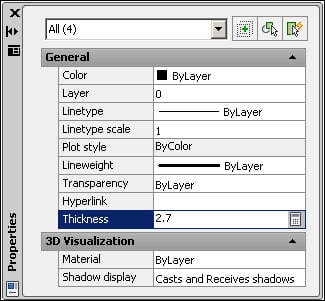

3D polylines
Polylines created with the PLINE command are 2D, not allowing for vertices with different Z coordinates. These polylines are designed by lightweight polylines. But what if a single object is needed to be composed by segments whose endpoints have different Z coordinates?
The answer is to create 3D polylines. Three processes are available:
-
3DPOLY: This command (alias3P) creates 3D polylines from the start. It works like theLINEcommand, but the result is a single object. -
JOIN: This command (aliasJ) creates 3D polylines from a contiguous sequence of lines with shared endpoints. It is enough that one endpoint of a line is out of the plane for a 3D polyline to be created. -
PEDIT: The same command (aliasPE) used for the creation of 2D polylines from lines and arcs can also be applied to join lines to a 3D polyline. The first object must already be a 3D polyline.
Note
Starting with version 2012, the best way to apply the JOIN command is to select all the line segments at the first command prompt, without specifying a source object. Depending on the type of selected objects and their positions, the most suitable object is automatically created.
And in what situations may we have utility for 3D polylines?
3D polylines are particularly useful to measure objects that develop in different directions, such as piping or wiring, and to define paths for other 3D objects such as piping. The creation of 3D solids and surfaces from linear objects is the subject of Chapter 4, Creating Solids and Surfaces from 2D .
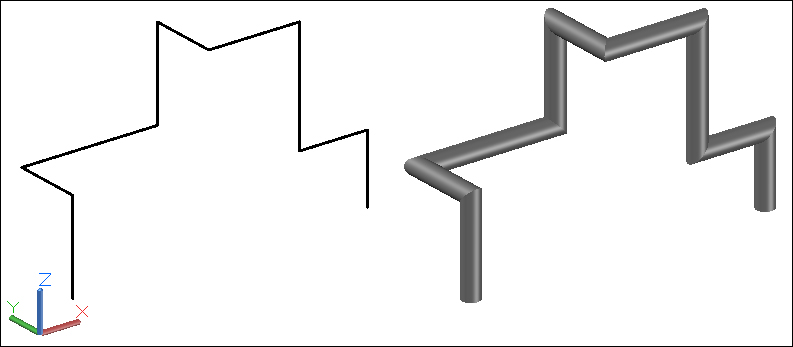
Splines and helixes
Splines are smooth linear objects, normally without corners that pass through or near specified points. Spline is short for Nonuniform Rational B-Spline ( NURBS ). Splines are described by a set of parametric mathematical equations, but have no fear, for AutoCAD will internally deal with this, we will not have to!
Splines are used whenever we need smooth curves and are also the foundation for NURBS surfaces, the most used surfaces in the automotive or aeronautic projects.
To create a spline we apply the (guess?) SPLINE command (alias SPL). By default, the command only prompts for the location of fit points, and the spline passes through the specified points. An Enter finishes the spline and the Close option creates a closed spline.
We can control splines by two sets of vertices:
-
Fit points: These are the points used to create the spline -
Control vertices: These are the points that define the spline
When selected, the small blue triangle allows switching between Fit points and Control vertices. To edit a spline is very simple: we select it, without command, and work with grips. We can either click a grip and move it, or we can place the cursor over a grip and on the grip menu choose to move the vertex, add one, or remove that vertex. This last process is known as multifunctional grip.

Note
Since AutoCAD 2012, the JOIN command is also a great tool for the creation of complex splines. We may have a contiguous and non-planar sequence of lines, arcs, elliptical arcs, splines that the result is a single spline.
With the HELIX command we can create 2D or 3D helixes or spirals. By default, the command prompts for the center point of the base, base radius, top radius, and height. As options, we have the position of the axis endpoint, the number of turns, the height of one complete turn, and the twist (if the helix is drawn in the clockwise or the counterclockwise direction). To edit a helix object, we can use grips or the PROPERTIES command.
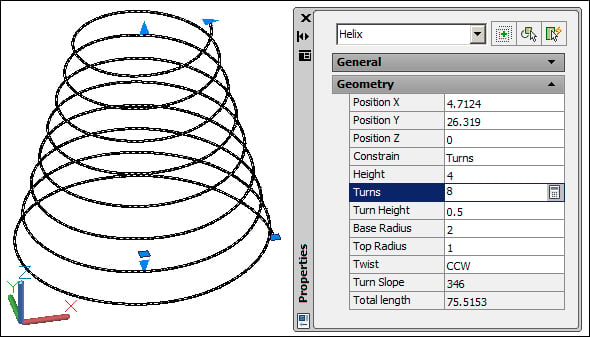
If we explode a helix object, the result is a spline. The BLEND command, new in Version 2012, creates a special spline that connects two open linear objects. The command only prompts for the selection of the first curve and the selection of the second curve. Selections must be near the endpoints to connect. The Continuity option allows for the choice of the applied type of continuity: Tangent with a tangency continuity (known as G1 continuity), or Smooth with a curvature continuity (known as G2).
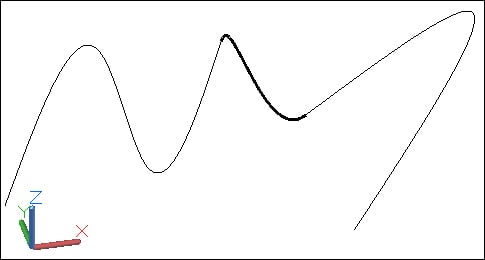
How to create great 3D models
There are several possibilities for starting a 3D project. We may:
-
Create a 3D project from a complete set of 2D drawings, with all the necessary views included. Here, we don't have to project or idealize; we just have to decide the best approach and the commands that are to be used.
-
Create a 3D project from a plant view and some other elements. Here we have to project a lot and probably have to study several possibilities in order to find the most suitable project.
-
Create a 3D project from scratch. We have nothing except some conditions about space, functionality, or others.
For any of these possibilities, the keyword is planning.
First, we have to carefully plan the work. Instead of immediately starting to model, it's better and less time-consuming to decide a draft sequence of tasks.
Some important questions at this phase:
-
Do I have access to something similar?
-
How complex will my project be?
-
Do I have some 3D blocks that I may use?
-
Have I created the needed layers and other definitions (layouts, styles, and so on) in another project?
-
Am I going to use external references in my project?
-
Do I have all the necessary information?
If we have 2D drawings, these must be carefully studied, especially if there are any inconsistencies between views and how to start.
Next, we set up our model. We can open the most important 2D drawing and save it with a different name; we can start a drawing and insert the other drawings as blocks or external references. We must verify if units are coherent, by applying the UNITS command.
Continuing set up, we create layers and other definitions. A winning command here is ADCENTER, also known as Design Center ( Ctrl + 2 ) that allows for gathering all layers, blocks, and other definitions from other drawings without opening them.
If we pretend to make some nice realistic images (rendering), we must be careful with layers, knowing that the easiest way to assign materials is by layer.
Should we start from floor plans or elevations? Well, it depends on the project. We can model from plans, but some parts may come from other views and then be positioned.
A final piece of advice is to keep several versions of your project. When an important step is achieved, we must save a backup copy. If we change our mind about a step or if the current file is corrupted, we minimize the losses.
Summary
In this chapter, we were introduced to 3D. We saw the importance of the third coordinate, how to enter points in absolute or relative coordinates, and the application of point filters. We analyzed workspaces and how to control the AutoCAD environment. The importance of layers, transparency, and other properties were then explained. Auxiliary tools were then covered before we looked at how to use them to ease the 3D project. We then saw the application of those commands in 3D used daily and some that are particularly important, such as BOUNDARY. We also covered the linear 3D commands and the Thickness property. We concluded the chapter by covering good practices when modeling in 3D.
Source: https://www.packtpub.com/product/autodesk-autocad-2013-practical-3d-drafting-and-design/9781849699358
0 Response to "How to Make 3d Drawing in Autocad 2013"
Post a Comment